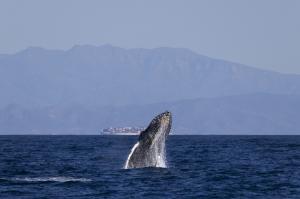Mid-Season Results from Protecting Blue Whales and Blue Skies Program (BWBS)
Expanded VSR Zone and Higher Award Tier Thresholds for Greater Impact
Every year I am inspired by the level of collaboration and commitment we see from industry leaders on this initiative, and 2025 is shaping up to be our biggest year of impact yet.”
CA, UNITED STATES, September 22, 2025 /EINPresswire.com/ -- Protecting Blue Whales and Blue Skies, a vessel speed reduction program for safer whales, cleaner air, and a quieter ocean, has released a mid-season report on the 2025 season, which runs May through December. — Jess Morten, California Marine Sanctuary Foundation
BWBS encourages and verifies shipping companies’ cooperation with NOAA’s voluntary Vessel Speed Reduction (VSR) requests to transit at 10 knots or less during the VSR season. Protecting Blue Whales and Blue Skies (BWBS) releases this status report at the half-way point summarizing how program participation and cooperation are trending.
Why 10 knots?
Ship strikes are a major threat to whales globally. In California waters, they threaten the recovery of endangered blue, fin, and humpback whales. Compared to transits at 15 knots, when large vessels reduce speeds to 10 knots, the risk of a fatal ship strike is reduced by nearly 50%. Additionally, with the region’s on-shore prevailing winds, a significant portion of ship emissions spreads into coastal communities, and can account for 50% or more of certain counties' air pollution- notably, smog-forming nitrogen oxides (NOx). When ships reduce speed, they reduce emissions by ~27% from baseline, helping protect public health, and reduce underwater radiated noise pollution.
All vessels 300 gross tons (GT) or larger that transit through any portions of the zones receive NOAA’s VSR request and bulk, tanker, car carrier, and container vessels 300 GT or larger also receive BWBS materials on how to enroll in the program. Benefits of participation include monthly reporting on each ship’s performance, whale sightings and risk data, inclusion in communications campaigns, as well as end-of-year comprehensive reports quantifying cumulative environmental benefits analyzed by research partners.
Mid-Season Highlights:
> 119% enrollment rate compared to last year- with 44 companies enrolled.
> 10 shipping lines are currently tracking to achieve the Sapphire award level (90%+ Cooperation rate), including: MSC, CMA CGM, NYK RoRo, OOCL, OSG Ship Management, CSL America, ConocoPhillips - Polar Tankers, Wan Hai Lines, Wallenius Wilhelmsen, and Swire Shipping (listed in order of most miles traveled).
> 13 lines tracking in the Gold award level include: Maersk, Ocean Network Express (ONE), COSCO Shipping, Yang Ming Marine Transportation, Hapag-Lloyd America, Seaspan Ship Management, Hyundai Glovis, The d’Amico Group, Swire Bulk, Scorpio Group, Eastern Pacific Shipping, Unisea Shipping Ltd, and BP Shipping Ltd (70-89% Cooperation rate).
> Participating vessels have traveled over 247,000 nautical miles (up from 220,000 at this point last season) in the zones, with 84% of that (or 207,288 nautical miles) traveled at 10 knots or less.
These results are especially notable as 2025 marks the first year that the Chumash Heritage National Marine Sanctuary (CHNMS) was added to the VSR zones, increasing the total coverage by ~2,600 square miles to a total of 25,806 square miles of important whale habitat off California’s coast. Further, the season marks a new threshold for achieving the Sapphire award level - lines must achieve a 90% or greater cooperation rate, up from 85%.
Rachel Rhodes, Benioff Ocean Science Laboratory, noted: "When you think about this effort in the context of what it means out in the water for endangered whales, and what we know about whale presence from sightings and acoustic detections this season, it's really humbling. On (one remarkable) day alone in the Channel in May, an aerial survey team sighted 92 humpback whales."
Jess Morten, California Marine Sanctuary Foundation (CMSF), said: "Every year I am inspired by the level of collaboration and commitment we see from industry leaders on this initiative, and 2025 is shaping up to be our biggest year of impact yet, with increased thresholds for recognition in each award category and a geographic expansion of the VSR zones equivalent to the size of the state of Delaware."
Global Context
This risk of ship strikes is not unique to the West Coast nor reserved to these zones. Recent studies outline how shipping occurs across 92% of whale ranges, but less than seven percent of risk hotspots have management strategies to reduce collisions. For the areas where management strategies exist, CMSF and the BWBS team recently launched an online map platform, the Whale Atlas, designed as a go-to resource so mariners can quickly understand where whale protection measures exist across the globe and how to make operational and logistical adjustments to protect marine biodiversity.
About the Program
Learn more about ways to get involved and the impact of voluntary maritime efforts at: bluewhalesblueskies.org. Shipping companies are eligible to enroll at any point during the season.
Becca Tucker
Protecting Blue Whales and Blue Skies
becca@californiamsf.org
Visit us on social media:
LinkedIn
Legal Disclaimer:
EIN Presswire provides this news content "as is" without warranty of any kind. We do not accept any responsibility or liability for the accuracy, content, images, videos, licenses, completeness, legality, or reliability of the information contained in this article. If you have any complaints or copyright issues related to this article, kindly contact the author above.


